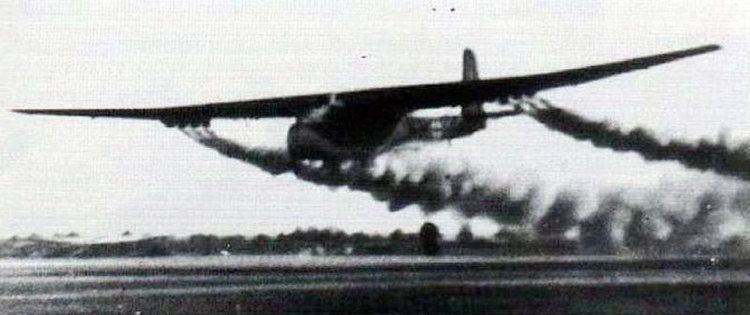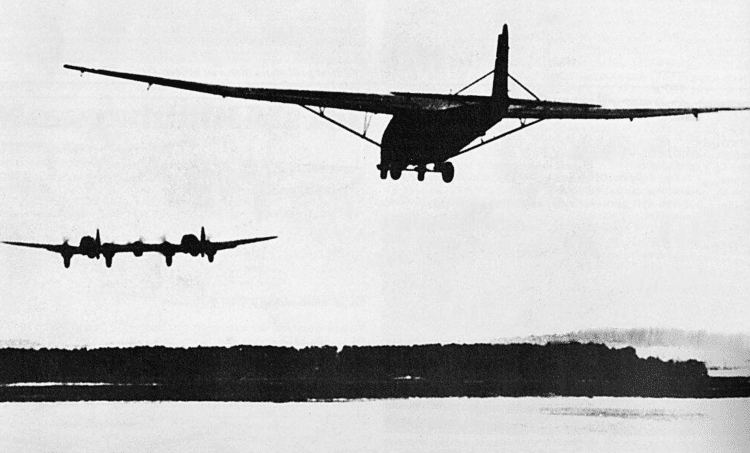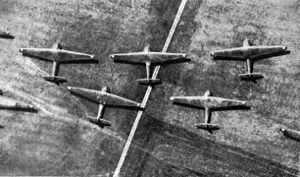Top speed 161 km/h Length 28 m First flight February 25, 1941 | Wingspan 55 m Introduced 1941 | |
 | ||
Messerschmitt me 321 323 gigant
The Messerschmitt Me 321 Gigant was a large German cargo glider developed and used during World War II. It was developed into the six-engined Messerschmitt Me 323 Gigant.
Contents
- Messerschmitt me 321 323 gigant
- Messerschmitt me 321 me 323 gigant
- Development
- Design
- Operational history
- Variants
- Specifications Me 321B
- References

Messerschmitt me 321 me 323 gigant
Development

During the preparations for a possible invasion of Britain during World War II (Operation Sea Lion) it became obvious to the Luftwaffe's Transport Command that there was a need for a larger capacity cargo- and troop-carrying aircraft than its mainstay, the Junkers Ju 52.

When the plans for Operation Sea Lion were shelved in December 1940, and planning began for the invasion of Russia (Operation Barbarossa), it was decided that the most cost-effective solution to the need for transport aircraft was to use gliders. Accordingly, the Technical Bureau of the Luftwaffe issued a tender for rapid development of a Grossraumlastensegler ("large-capacity transport glider") to the aircraft manufacturers Junkers and Messerschmitt. The specification called for the glider to be capable of carrying either an 88 mm gun plus its tractor, or a medium tank. The codename Projekt Warschau ("Project Warsaw") was used, with Junkers being given the codename Warschau-Ost and Messerschmitt Warschau-Süd.

However, the Junkers design, the Ju 322 Mammut was unsuccessful due to the company opting to use all-wood construction. Messerschmitt's design for this transport glider consequently secured the contract for the company. Initially given the RLM designation: Me 263; this designation number was later reused (see: RLM) for the second generation rocket fighter developed in 1945: Messerschmitt Me 263. That number was 'freed-up' when the number for this aircraft was switched to: Me 321.
Design

The Me 263 had a framework of steel tubing provided by the Mannesmann company, with wooden spars and a covering of doped fabric. This allowed for quick construction and easy repair when needed and also saved weight. The Me 263 was redesignated the Me 321 and was nicknamed Gigant ("Giant") due to its huge size.
Its nose stood over 6 m (20 ft) high, and was made up of two clamshell doors. The doors could only be opened from the inside, when ramps would be used to allow vehicles to drive in or out. Compared to the Ju 52, the Me 321 offered a load area six times larger, at around 100 m2 (1,100 sq ft), and could accommodate a gross cargo weighing up to 23 t (23 long tons). The cargo space had been designed to replicate the load space of a standard German railway flatcar, allowing any cargo that could travel by rail to fit into an Me 321. Alternatively, if used as a passenger transport, 120-130 fully equipped troops could be accommodated.
The Me 321 was fitted with a jettisonable undercarriage comprising two Bf 109 tailwheels at the front and two Junkers Ju 90 main wheels at the rear and was intended to land on four extendable skids.
The first flight of the prototype Me 321 V1 took place on 25 February 1941, towed into the air by a Ju 90. It was piloted by Messerschmitt test pilot Karl Baur, and carried 3 tonnes (3 tons) of ballast. Baur reported that the controls were heavy and responses sluggish and it was decided to enlarge the cockpit to accommodate a co-pilot and radio operator and dual controls were fitted. Electric servo motors were also fitted to assist in moving the huge trailing edge flaps and further tests caused a braking parachute to also be added.
The test flights were plagued by takeoff difficulties, since the Junkers Ju 90 was not powerful enough, and as an interim measure three Bf 110 heavy fighters were used, in a so-called Troikaschlepp, with the trio of twin-engined fighters taking off together in a V formation. This was a highly dangerous manoeuvre and Ernst Udet asked Ernst Heinkel to come up with a better aerial towing method. Heinkel responded by creating the Heinkel He 111Z Zwilling ("Twins"), which combined two He 111 aircraft through the use of a new "center" wing section with a fifth engine added. Underwing-mount Walter HWK 109-500 Starthilfe rocket-assisted takeoff units were also used to assist takeoff from rough fields.
Operational history
The first Me 321 A-1 production aircraft entered service in May 1941 with Grossraumlastensegler 321 at Leipheim, initially towed by Ju 90s and later by the He 111Z and the Troikaschlepp arrangement of three Bf 110s. The triple Zerstorer arrangement was very dangerous in the event that one or more of the takeoff booster rockets failed. One such failure did occur in 1941, which led to the collision of the tow-planes and the deaths of all 129 occupants of the four aircraft. This accident was the deadliest in the history of aviation at the time. The death toll would not be matched until the Tachikawa air disaster of 1953 and would not be exceeded until the 1960 New York mid-air collision. The later Me 321 B-1 variant had a crew of three and was armed with four 7.92 mm (.312 in) MG 15 machine guns.
The Me 321 was less than successful on the Eastern Front for various reasons:
In early 1942, the remaining Me 321s were withdrawn from service in Russia in anticipation of the planned Operation Herkules, the invasion of Malta, in which a fleet of the gliders hauled by He 111Zs were to be used. The plan was abandoned due to a lack of towing aircraft.
In 1943, the Me 321s were returned to Russia to be used in a projected operation to relieve General Friedrich Paulus’ besieged army at Stalingrad, but by the time they reached the front line, no suitable airfields remained and they were sent back to Germany.
Following the cancellation of the Stalingrad operation, the Me 321 gliders were mothballed, scrapped, or converted into the powered variant, the Me 323 with six 895 kW (1,200 hp) engines. This was the biggest land-based cargo aircraft of World War II. A further proposed operation — in which the remaining Me 321s would have landed troops on Sicily — was also abandoned, due to a lack of suitable landing sites.
Ultimately, 200 Me 321s were produced.
Variants
Specifications (Me 321B)
Data from German Aircraft of the Second World War
General characteristics
Performance
Armament
